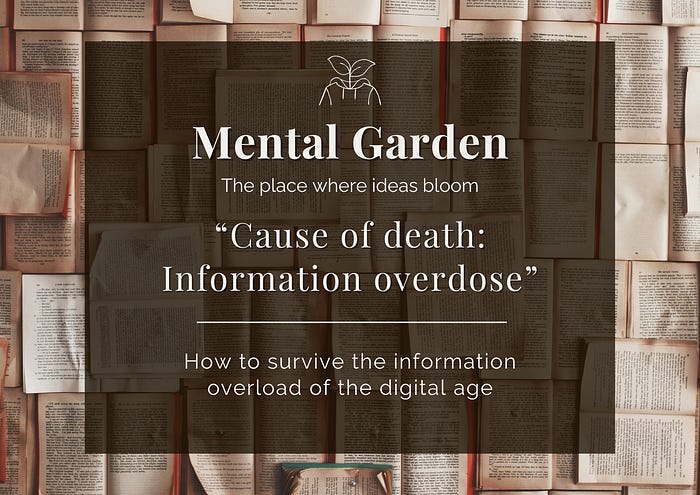Cause of death: Information overdose
How to survive the information overload of the digital age
🏷️ Categories: Attention, Memory
The clock struck 9:43 in the morning when the silence of the house was interrupted by the macabre discovery of a lifeless body. A young, middle-aged man lay on the living room floor, surrounded by two policemen while a coroner crouched to examine the corpse, and several relatives watched the scene with distraught expressions. Concerned by the lack of response from their relative to phone calls and knocks on the door in the preceding days, the family made the decision to inform the authorities. They did not expect this outcome.
The room they were in, although spacious in its design, was suffocated by the disorder of books, newspapers, and magazines piled up in every corner. Amidst the chaos, the man lay motionless. The television, left on before his demise, murmured in the background, breaking the uncomfortable silence. The body showed no signs of violence, the windows throughout the room were closed, the door lock had to be forced to gain entry into the home, everything inside was clean and nothing was broken. What could have happened?
The policemen turned to the deceased’s mobile phone in search of possible clues. Upon unlocking the phone, the screen revealed numerous missed calls, unread messages, and social media notifications flooding the screen, a whirlwind of content waiting to be attended to. The deceased’s computer was thoroughly inspected; a hard drive with a capacity of 2 terabytes of storage, with barely 5 gigabytes free, was the only clue found inside.
A week later, the autopsy confirmed the obvious, as the initial hypothesis had suggested. The autopsy report issued by the authorities, which closed the case, read as follows: “Cause of death: Information overload.”
This brief story I have just told you gives rise to today’s topic, a reflection on the exorbitant consumption of information in the digital era in which we live.
Overinformation in numbers
I think it’s not just me, but all of us. We’re all immersed in a vortex of excessive information. The avalanche of news, notifications, and messages seems endless; there’s an incessant production of content, every day, around the clock.
In fact, the average person consumes about 35 gigabytes of information daily (Bohn & Short, 2012), which means that in Spain alone, approximately 0.6 zettabytes were consumed last year. What’s a zettabyte? 1 zettabyte (ZB) equals the modest amount of 1000000000000 gigabytes, “a million million gigs,” in case you got lost amidst all those zeros in the number.
The magnitude of information produced today is overwhelming when you stop to think about it. Every minute, on average, 241 million emails are sent, 41.6 million Whatsapp messages are exchanged, 6.3 million Google searches are made, and 4 million “likes” are given on Facebook (Statista, 2024), among many other figures that seem impossible to occur every 60 seconds.
In this digital landscape, it’s hard not to feel overwhelmed. It’s entirely impossible to pay attention to all the content that interests us, and what’s worse, we’re unable to remember or utilize most of what we consume. There’s not enough time, memory, or attention to dedicate to this constant stimulation that our brains are accustomed to and that is harming us (Misra & Stokols, 2011).
Information in the past
On the news side, in the past, they were limited in time and space, with television news programs and newspapers dictating the flow of information. Did you want to stay informed? A daily newspaper and the midday news bulletin, that’s the news until tomorrow.
On the knowledge side, there have always been books, sources of invaluable information. They allow us to travel through time and into the minds of people who are no longer with us but have left in writing the best of their intellect. Books serve as support for the new geniuses to come. This idea comes from a beautiful Latin phrase: “nanos gigantum humeris insidentes,” translated as “dwarfs standing on the shoulders of giants.”
A significant difference between content in the past and the present is that today’s content actively demands your attention. The mobile phone, which you carry with you at all times, is continuously demanding your attention through sounds, vibrations, and notification lights. In contrast, a book or a newspaper left on a table remains passive, silent; it doesn’t vibrate or make noise to prompt you to open and read it.
How does the human brain cope with this constant stimulation? As humans have evolved, the brain areas dedicated to perceiving the world through the senses have become more prominent. Being able to quickly identify what is happening around us has been vital for our survival in detecting threats (such as a predator) or opportunities (such as food). This is known as selective attention and helps us filter information to remember only what is crucial (Johnston & Dark, 1986).
Having access to mobile phones or computers all the time tests the brain’s selective attention in entirely new ways. These technologies create an environment in which we constantly switch our attention between important and unimportant things, keeping us in a state of constant alertness. So much so that there is even the phenomenon of phantom vibration, where people feel that their phone has vibrated when it hasn’t (Y. H. Lin et al., 2013; Drouin et al., 2012).
The importance of attention
The continuous stimulation began with the expansion of the internet, as content became more abundant and easily accessible, the competition among companies to attract your attention has increased (Crowdcentric Media, 2014). There are more and more things to distract ourselves with, yet the day still has only 24 hours; attention is a scarce resource, and we must know how to use it wisely, carefully considering what we want to focus on.
What happens if we don’t take care of our attention? Let me give you an example that we can all relate to. Imagine you’re working on a task for which you’re highly motivated. You know exactly what you need to do, and you’re fully concentrated on it, your attention making you productive. However, you need to look up information online, and during your search, a couple of computer notifications pop up or your phone rings. These are distractions, they interfere with your attention and take you away from what you were doing. It’s as if someone were constantly tapping you on the shoulder to get your attention. Could you focus under these conditions?
The problem is that once you’ve lost the attention you had focused on something, it’s difficult to regain it, it’s not instantaneous. This attentional cost is what completely disrupts your inspiration and performance in your task (Smallwood & Schooler, 2006; Smith, 2003).
Unlike other stimuli like the wind blowing in the trees, the mobile phone attracts our attention much more, but why is this difference if both are equally perceptible stimuli? Through selective attention, the brain inhibits superfluous stimuli; we pay attention to what matters to us. If the phone rings, it’s because something is happening, whether it’s important, interesting, funny, urgent… who knows, but just by ringing, it has disrupted your concentration.
Being attentive to several things has been shown to negatively affect students’ academic performance (Heim & Keil, 2012), and in general, multitasking overloads our cognitive capacity, making it difficult to memorize (Rockwell & Singleton, 2007) and to distinguish what is important from what is not (Lin, 2009; Cain & Mitroff, 2011; Ophir et al., 2009; Klingberg, 2008; Foerde et al., 2006).
Knowing how to rest
In contrast to selective attention, which is focused on something specific, we have diffuse attention, which is essentially keeping the cognitive system active to perceive new stimuli from the environment without paying special attention to any of them. This is what happens when we wander or take a walk without any plan.
Because we are accustomed to receiving stimulation all the time, the threshold at which people start to get bored has decreased. People nowadays become impatient more quickly if they stop receiving external stimuli. In the past, individuals had intervals of time during which they were expected to do something, such as waiting for the train or the bus. These moments of boredom were positive in that they allowed the mind to wander, reflect silently, and simply observe the surroundings.
It may seem like a trivial matter, but it’s not. Boredom fosters creativity because it forces a person to be alone with their thoughts and reflect (Schooler et al., 2011). This only occurs if we temporarily isolate ourselves from the rest of the world, without receiving stimuli from anything or anyone. I always notice, and there isn’t a single person who doesn’t “make use of” the waiting time at the bus stop or during the journey to look at something on their mobile phone, something that in most cases is completely irrelevant, but at least it serves to entertain them. Anything to avoid being alone with their thoughts.
When we are productive doing something, we focus all our attention on one thing, but this is an enormous mental effort, which forces us to rest. If we spend too much time during the day attending to trivial stimuli, we will already be too tired by the time we really need to concentrate.
Digital Minimalism
Now that we’ve explored the problem, how it has developed, and how it affects us, let’s discuss what we can do to address it. In this section, we’ll draw from the insights of a book that I consider a reference in this field: “Digital Minimalism” by Cal Newport, published in 2019. Here are some techniques you can use to escape the flood of content and distractions and focus on what truly matters to you:
Spend time alone for introspection:
Dedicate daily time to disconnect from digital devices and spend time with yourself. You need solitude; it will allow you to reflect, be more creative, find new solutions, and rest for when you need to focus. Don’t worry, you won’t get bored; you have much to discuss with yourself.
For example, reserve 15 or 20 minutes each morning to meditate before starting your day. Keep your phone away and find a quiet place where you can be alone with your thoughts. Personally, I’ve applied this technique through the use of a journal. Here’s how I’m doing it and how it’s going:
Reduce participation in social media:
Stop automatically liking and sharing everything you come across in your endless scroll. Instead of spending time seeking instant gratification or entertainment by endlessly scrolling through your phone, seek activities that provide long-term satisfaction and give meaning to your life. Develop a hobby, learn a new skill, or engage in a new sport. Set goals.
For example, set time limits for your social media use and be selective about your consumption. It’s okay to seek entertainment, but be aware of the time you’re spending, and remember not to neglect face-to-face human contact and fulfilling activities. It’s even better if they involve friends.
Non-digital leisure:
Spending time on leisure activities that don’t involve screens or technology is essential for maintaining a healthy balance. Find hobbies that satisfy you outside of watching TV series and playing video games. Try reading a book or exercising outdoors.
For example, block off time in your weekly schedule for technology-free leisure activities. You could dedicate weekend afternoons to hiking in nature, exploring new places in your city, or enjoying an afternoon of board games with friends.
Personally, I implement this technique through forest walks and mountain biking. In my first post, I discussed the scientifically proven benefits of these walks.
Your attention is the most valuable resource in the attention economy:
Be aware that companies are vying for your attention; disable all types of notifications, leaving only those that are essential to your life. Unfollow accounts that you hardly consume or that aren’t adding value to your life, and focus on what truly benefits you and what you can make use of.
If you’ve made it this far I’ve definitely got your attention. I hope it’s because you’re finding it useful. What do you think, does the internet, news and social media overload you?
📚 References
Bohn, R. E., & Short, J. E. (2012). Measuring Consumer Information. International Journal Of Communication, 6, 980–1000. https://ijoc.org/index.php/ijoc/article/view/1566/743
Cain, M. S., & Mitroff, S. R. (2011). Distractor Filtering in Media Multitaskers. Perception, 40(10), 1183–1192. https://doi.org/10.1068/p7017
Crowdcentric Media. (2014). ON! The Future of Now: Making Sense of our Always On, Always Connected World. LULU.
Drouin, M., Kaiser, D. H., & Miller, D. A. (2012). Phantom vibrations among undergraduates: Prevalence and associated psychological characteristics. Computers In Human Behavior, 28(4), 1490–1496. https://doi.org/10.1016/j.chb.2012.03.013
Foerde, K., Knowlton, B. J., & Poldrack, R. A. (2006). Modulation of competing memory systems by distraction. Proceedings Of The National Academy Of Sciences Of The United States Of America, 103(31), 11778–11783. https://doi.org/10.1073/pnas.0602659103
Heim, S., & Keil, A. (2012). Developmental Trajectories of Regulating Attentional Selection Over Time. Frontiers In Psychology, 3. https://doi.org/10.3389/fpsyg.2012.00277
Johnston, W., & Dark, V. J. (1986). Selective attention. Annual Review Of Psychology, 37(1), 43–75. https://doi.org/10.1146/annurev.ps.37.020186.000355
Klingberg, T. The Overflowing Brain: Information Overload and the Limits of Working Memory (New York, NY, 2008; online edn, Oxford Academic, 31 Oct. 2023), https://doi.org/10.1093/oso/9780195372885.001.0001
Lin, L. (2009). Breadth-biased versus focused cognitive control in media multitasking behaviors. Proceedings Of The National Academy Of Sciences Of The United States Of America, 106(37), 15521–15522. https://doi.org/10.1073/pnas.0908642106
Lin, Y. H., Lin, S., Li, P., Huang, W., & Chen, C. Y. (2013). Prevalent Hallucinations during Medical Internships: Phantom Vibration and Ringing Syndromes. PLOS ONE, 8(6), e65152. https://doi.org/10.1371/journal.pone.0065152
Misra, S., & Stokols, D. (2011). Psychological and Health Outcomes of Perceived Information Overload. Environment And Behavior, 44(6), 737–759. https://doi.org/10.1177/0013916511404408
Newport, C. (2019). Digital Minimalism: Living Better With Less Technology. Penguin UK.
Nicolas Poussin | Blind Orion Searching for the Rising Sun | The Metropolitan Museum of Art. (1658). The Metropolitan Museum Of Art. https://www.metmuseum.org/art/collection/search/437326
Ophir, E., Nass, C., & Wagner, A. D. (2009). Cognitive control in media multitaskers. Proceedings Of The National Academy Of Sciences Of The United States Of America, 106(37), 15583–15587. https://doi.org/10.1073/pnas.0903620106
Rockwell, S. C., & Singleton, L. A. (2007). The Effect of the Modality of Presentation of Streaming Multimedia on Information Acquisition. Media Psychology, 9(1), 179–191. https://doi.org/10.1080/15213260709336808
Schooler, J. W., Smallwood, J., Christoff, K., Handy, T. C., Reichle, E. D., & Sayette, M. A. (2011). Meta-awareness, perceptual decoupling and the wandering mind. Trends In Cognitive Sciences. https://doi.org/10.1016/j.tics.2011.05.006
Smallwood, J., & Schooler, J. W. (2006). The restless mind. Psychological Bulletin, 132(6), 946–958. https://doi.org/10.1037/0033-2909.132.6.946
Smith, R. E. (2003). The cost of remembering to remember in event-based prospective memory: Investigating the capacity demands of delayed intention performance. Journal Of Experimental Psychology: Learning, Memory And Cognition, 29(3), 347–361. https://doi.org/10.1037/0278-7393.29.3.347
Statista. (2024, 2 enero). User-generated internet content per minute 2023 | Statista. https://www.statista.com/statistics/195140/new-user-generated-content-uploaded-by-users-per-minute/











At the risk of further overloading my limited attention span, I think your insight will be worth following. Thank you.
Headed out to paddleboard now, Homie